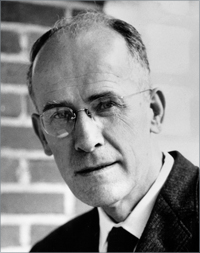Robert Brode (1900-1986) was an American physicist.
In 1941, at the outset of the war, Robert Brode went to work in the Applied Physics Laboratory at Johns Hopkins University to aid the development of the proximity fuse. Two years later, he was placed at Los Alamos and put in charge of a team that was tasked with the creation of a fuse for an atomic bomb that would cause the bomb to detonate at a certain height. Brode’s goal was to construct a fuse that had only the most miniscule chance of failing within 200 ft. of the intended detonation height. After testing both radar proximity fuses and barometric alimeter fuses, Brode’s group decided on a modified Monica tail warning radar fuse that was used successfully on both Little Boy and Fat Man.
During his stay at Los Alamos, his wife, Bernice Brode, accompanied him and eventually wrote memoirs about their experiences being a part of the Manhattan Project.
Early Life
Robert Brode was born in Walla Walla, Washington in 1900, the son of a professor of biology at Whitman College. After graduating from Whitman College, Brode went on to receive his Ph.D in physics from the California Institute of Technology in 1924. After receiving various scholarships and fellowships, Brode became an assistant professor of physics at Berkeley in the late 1920s and a full professor in the early 1930s. He remained there until his placement at Johns Hopkins in 1941.
Later Years
After Los Alamos, Brode returned to his teaching position at Berkeley. In 1950, Brode was one of 12 scientists who petitioned President Truman to ensure that the United States would never be the first nation to use the hydrogen bomb. He remained at Berkeley for the rest of his life and held various positions at the university while maintaining his professorship and research, including being the academic assistant to two of the university’s presidents. Robert Brode died in his Berkeley home in 1986.





